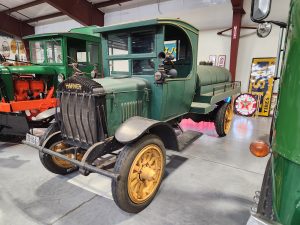Featured Truck of The Month
1922 Harvey 2.5 Ton
A Bit of History:
- Harvey trucks were built by the William E Dee company, a manufacturer of clay construction products based in Harvey, Illinois. Originally, they only built trucks for company use but they eventually began to sell to outside customers as well. The first Harvey offered on the market was a 1912 or 1913 model.
- Harvey trucks are assembled trucks, meaning all the parts were sourced by other manufacturers and assembled on site.
- Engines for Harvey trucks were sourced from Buda, a popular choice in the 1910s-1920s. Incidentally, the Buda plant was located right next to the William E Dee Plant in Harvey, Illinois.
- Like many small truck manufacturers, Harvey was unable to survive the Great Depression. The firm folded in 1932.
Fun Facts:
- This truck was almost destroyed in 1963. It had been stored in an old building that was being torn down, and a bystander came by at the right moment to stop the construction crew.
- Unlike most trucks of this age, our Harvey is almost entirely original. The only major features that aren’t original are the oil tanker (the truck was originally a flatbed) and paintjob.
- This truck, along with years’ worth of research materials, was donated by the family of Tom Bushley.


